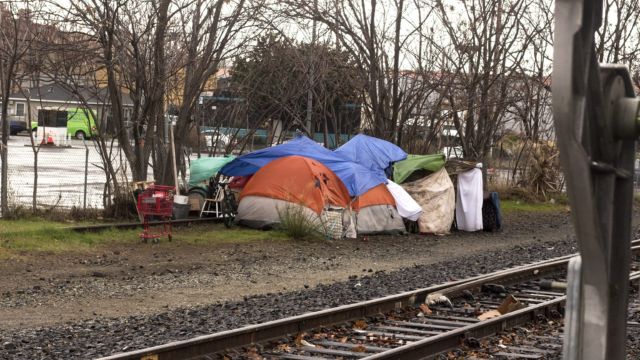Santa Clara County on Wednesday began counting unhoused residents, and this time it’s paying people who’ve lived on the streets to help.
This year, those paid workers, along with hundreds of trained volunteers and outreach teams, will go around the county to not only count how many people are living unhoused but also try to find out why.
The workers will connect the unhoused residents with an app to perform surveys rather than going back and surveying them weeks later as they’ve done in the past.
Supportive Housing Director KJ Kaminski says that critical information will help move the unhoused community forward.
“There is no perfect way to count every person in the community, and while numbers are a piece of the puzzle, and important, what we really want to know is what are the causes of homelessness; how can we better use our resources and our programs to address them,” Kaminski said. “Not only those causes but provide resources they need to exit homelessness and become housed.”
During the last “point in time” count in 2023, Santa Clara County had more than 9,900 people living on the streets or in temporary shelters, the highest of the nine Bay Area counties.
Santa Clara County, one of California’s most affluent regions, is grappling with a homelessness crisis that continues to grow in scale and complexity. To better understand the scope of the problem and address the needs of the homeless population, the county has conducted its annual homeless population count. This crucial effort, typically held in January, helps local officials and organizations assess trends, allocate resources, and plan strategies to support individuals experiencing homelessness.
The latest count provides new insights into the state of homelessness in the region and underscores the challenges faced by the county’s most vulnerable residents. Here’s a breakdown of the results and what they mean for the future of homelessness services in Santa Clara County.
A Comprehensive Count
The annual homeless population count is a critical tool in tracking the prevalence of homelessness across the county. The process involves volunteers and outreach workers conducting a one-night survey of individuals living in shelters, on the streets, in vehicles, or in other places not meant for human habitation. In addition to a physical count, outreach teams also gather demographic data to help shape targeted interventions.
The count is conducted by the Santa Clara County Homeless Census and Survey, which is part of a statewide effort mandated by the U.S. Department of Housing and Urban Development (HUD). The data collected is essential for understanding the severity of homelessness, measuring the effectiveness of existing programs, and determining the level of funding needed to meet the growing demand for services.
Key Findings from the Latest Count
The latest homeless population count in Santa Clara County paints a picture of both progress and ongoing challenges:
- Increase in Total Homeless Population: The count revealed an increase in the number of people experiencing homelessness across the county. Despite various interventions, such as expanded shelter beds and outreach services, more individuals and families are being pushed into homelessness due to rising housing costs, the economic impact of the pandemic, and a lack of affordable housing options.
- Higher Numbers of Unsheltered Individuals: One concerning trend identified in the count is the growing number of people living in unsheltered conditions. This includes individuals who are sleeping in parks, on sidewalks, in vehicles, or in abandoned buildings. The number of unsheltered individuals has risen significantly, highlighting the need for more shelter spaces and permanent housing solutions.
- Demographic Shifts: The data also highlights some significant demographic shifts. The homeless population includes a broad range of individuals, with an increasing number of families, older adults, and youth experiencing homelessness. While many homeless individuals are single adults, there has been a notable rise in the number of families with children who are unable to secure stable housing due to rising rents and limited affordable options.
- Ethnic Disparities: Racial and ethnic disparities within the homeless population continue to be a concern. African Americans, Latinos, and Native Americans are disproportionately represented among those experiencing homelessness. These disparities are reflective of broader systemic issues, including economic inequality, discrimination, and limited access to affordable housing.
The Impact of Rising Housing Costs

Santa Clara County’s homelessness crisis is closely tied to its housing affordability issues. The county is home to Silicon Valley, one of the most expensive real estate markets in the country.
With housing prices skyrocketing and wages not keeping up, many individuals and families are just one emergency away from losing their homes.
New California Law Could Raise Car Insurance Premiums by $400—Here’s What You Need to Know
Rents in Santa Clara County have increased dramatically over the past decade, and the COVID-19 pandemic only exacerbated the problem. Job losses, temporary furloughs, and the overall economic instability caused by the pandemic have pushed more people into precarious living situations, where they face the constant threat of eviction or displacement.
In addition to rising rent, the availability of affordable housing units in Santa Clara County is limited. While new developments are being built, they often target higher-income individuals or come with rents that are out of reach for low-income residents. As a result, many individuals find themselves living paycheck to paycheck, unable to save for emergencies or secure stable housing.
Solutions and Next Steps
While the numbers from the latest homeless count are concerning, they also offer an opportunity for local leaders to reassess their approach to solving homelessness. The county has already taken significant steps to address the issue, including:
- Increasing Shelter Capacity: Santa Clara County has worked to expand emergency shelter beds and temporary housing options for individuals experiencing homelessness. However, the need for more permanent, long-term solutions is clear. The county has committed to investing in supportive housing, which pairs permanent housing with wraparound services like mental health care, addiction support, and job training.
- Rent Subsidies and Housing Vouchers: The county has introduced several initiatives to help individuals and families who are at risk of homelessness. Programs like rent subsidies and housing vouchers aim to help low-income residents secure stable housing without having to compete in the high-cost rental market.
- Coordinated Outreach and Services: A key focus in recent years has been improving the coordination of outreach efforts and services. By partnering with nonprofits, local governments, and other stakeholders, the county is working to provide more comprehensive services to those experiencing homelessness. This includes access to mental health and addiction services, job placement programs, and case management.
- Prevention Strategies: One of the most effective ways to reduce homelessness is to prevent it in the first place. Santa Clara County is focusing on early intervention and prevention strategies, such as providing financial assistance to those facing eviction, offering mediation services between tenants and landlords, and increasing the availability of affordable housing.
The Road Ahead
The latest homeless population count in Santa Clara County serves as a stark reminder that the region’s homelessness crisis is far from over. While the count highlights the challenges ahead, it also shows that efforts to address homelessness are critical. With the right investments in affordable housing, shelter programs, and services, the county has the potential to make meaningful strides in reducing homelessness and ensuring that all residents have access to a safe and stable place to call home.
As the county continues to track homelessness trends, local leaders, nonprofits, and community members must work together to build innovative solutions, advocate for affordable housing policies, and support those in need. Only through sustained collaboration and commitment can Santa Clara County make real progress in combating homelessness and creating a more equitable and resilient community.



